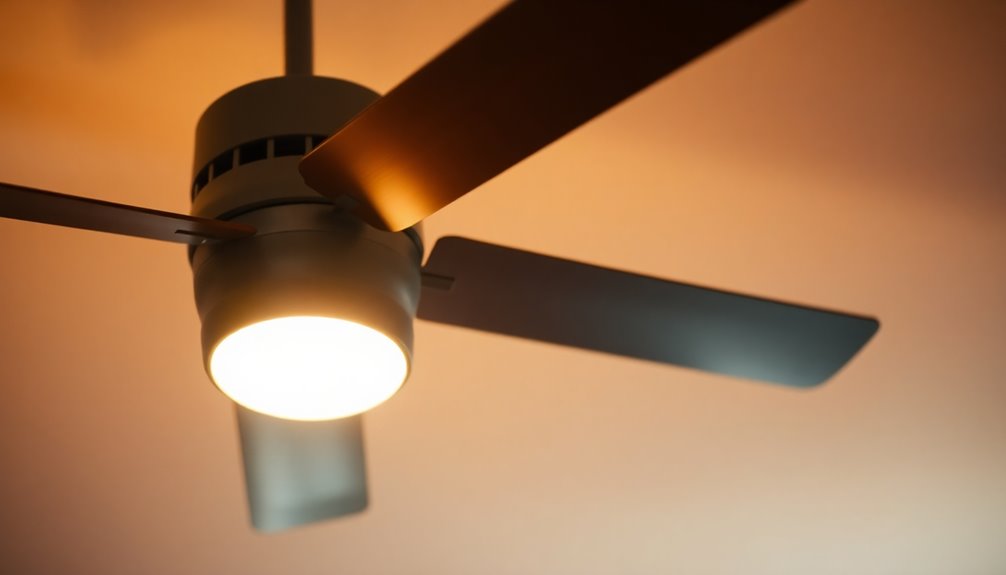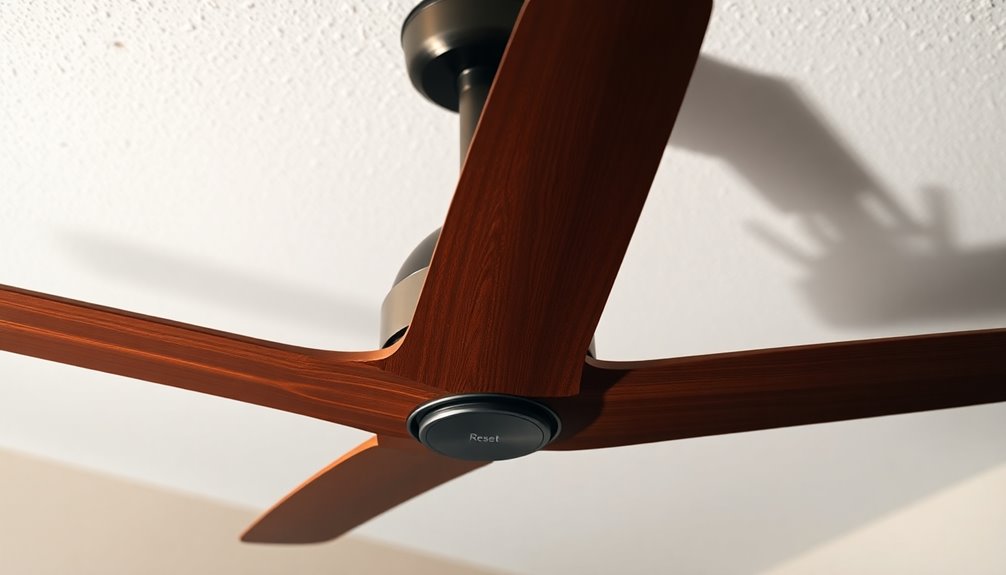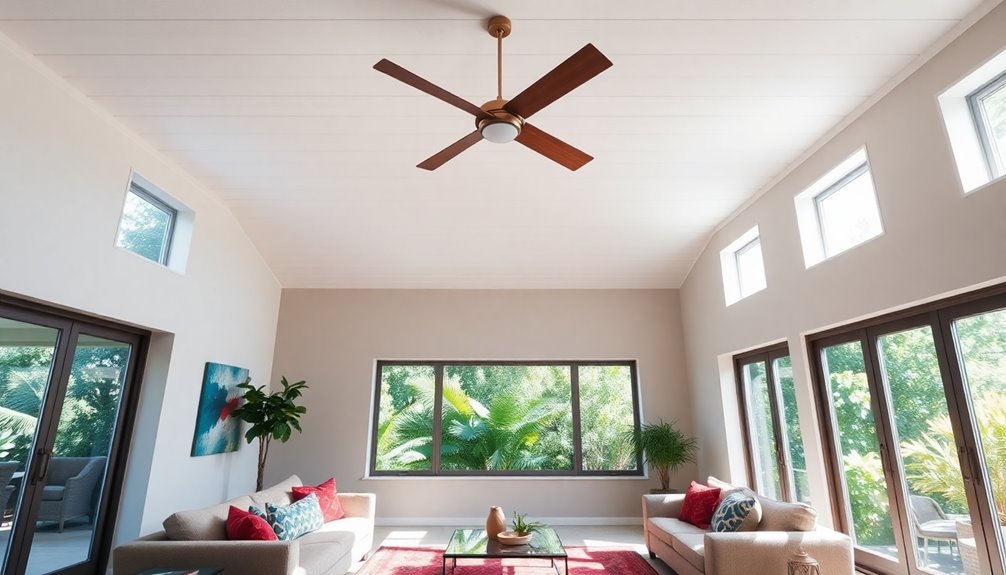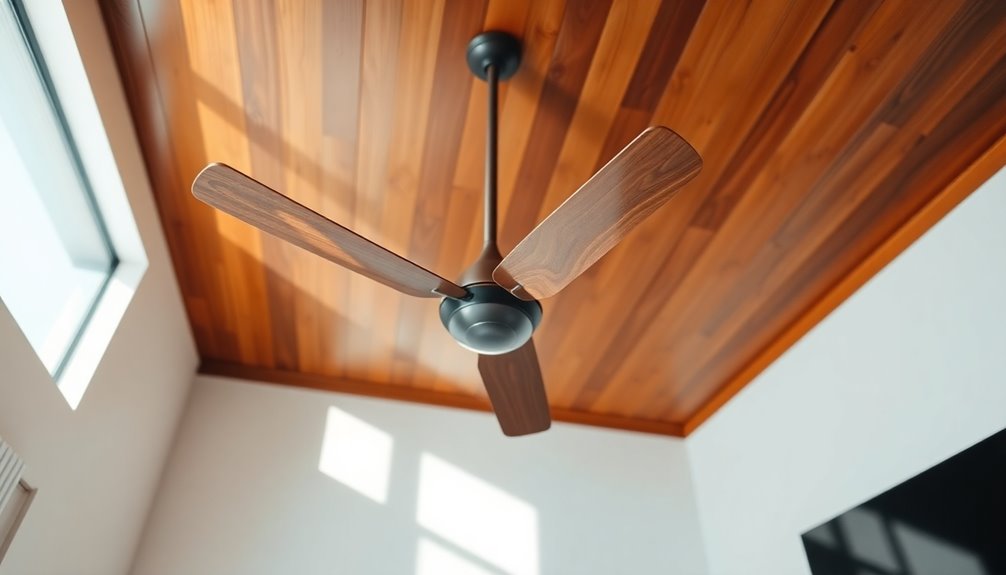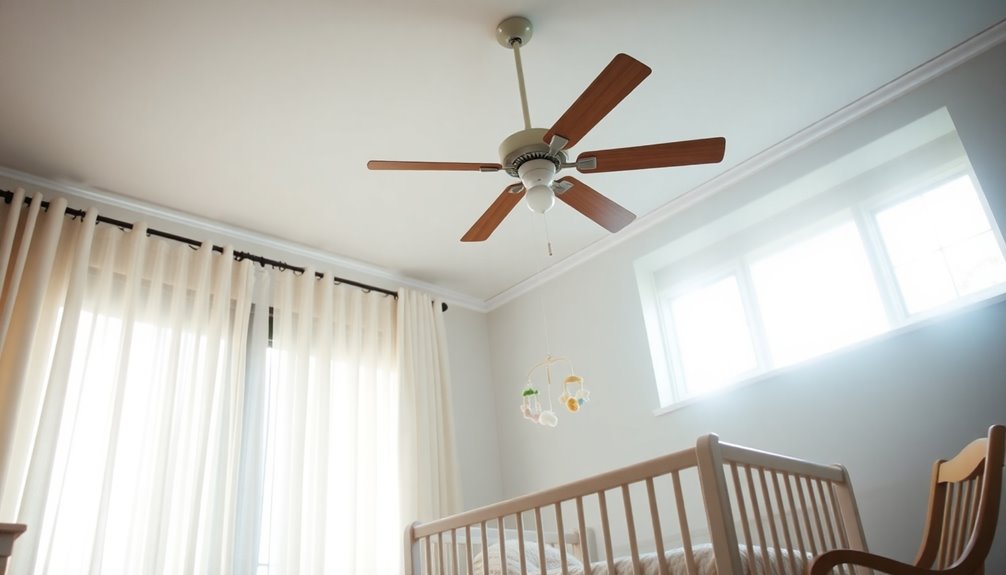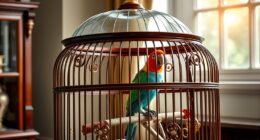A clicking ceiling fan often means you've got loose components or misalignments that need your attention. Check for loose screws on the blade arms; ensuring they're tight can solve the problem. Inspect the canopy and hanging bracket for any signs of instability, as loose connections can create noise. Remember to maintain your fan regularly by cleaning and lubricating its parts, as this prevents issues from arising. If you're looking to enhance your fan's performance and quiet operation, there are specific maintenance tips you can explore for a smoother experience.
Key Takeaways
- Clicking noises in ceiling fans often result from loose screws on blade irons or canopy, causing misalignment.
- A hanging bracket or electrical outlet box that is unfastened can lead to persistent clicking sounds during operation.
- Exposed wiring in flush mount fans can rub against the motor, producing clicking noises.
- Regular maintenance, including lubrication and cleaning, can prevent and reduce clicking sounds in ceiling fans.
- Ensuring proper alignment of blades and secure attachment to the motor is crucial to eliminate clicking noises.
Common Causes of Clicking Noises

When you hear clicking noises from your ceiling fan, it's often due to a few common causes that are relatively easy to address. One primary culprit could be loose screws on the blade irons. These screws hold the fan blades in place, and if they're not tightened properly, they can create those annoying clicking sounds.
Another issue might be a loose canopy. If the canopy isn't securely fastened to the ceiling, it can lead to misaligned components that produce clicking noises during operation. It's vital to inspect the attachment points to confirm everything's snug and secure.
Additionally, if the hanging bracket or electrical outlet box isn't tightly fastened, you'll likely encounter persistent ticking noises. Tension in these components can greatly reduce the chance of clicking sounds.
In flush mount fans, be aware that exposed wiring may rub against the motor, leading to further clicking.
Regular maintenance, such as checking for loose parts and confirming proper alignment, can help prevent these noises from occurring. By staying proactive, you can enjoy a quieter and more functional ceiling fan.
Troubleshooting Techniques for Clicking

To effectively troubleshoot the clicking noises from your ceiling fan, start by thoroughly checking all screws on the fan blades. Loose screws are a common cause of clicking sounds, so it's essential to guarantee everything is tightened.
Here are some steps to guide you:
- Inspect the blade arms: Check for any looseness in the blade holders. Ensure they're securely attached to prevent movement that could lead to clicking.
- Check for misalignment: Verify that the blades are properly aligned and free from obstructions. Misalignment may cause them to hit other parts of the fan or the ceiling.
- Examine the fan canopy: Look for signs of looseness or movement in the fan canopy. A loose canopy can create clicking noises during operation.
- Perform regular maintenance: Keep up with lubrication of moving parts and clean dust from the blades. This can help prevent clicking noises from developing over time.
Checking Loose Blade Screws

When your ceiling fan clicks, loose blade screws might be the culprit.
Start by checking each screw that connects the blades to the blade iron, as they can loosen over time.
Once you identify any loose screws, you can use proper tightening techniques to eliminate that annoying noise.
Identifying Loose Screws
If you're hearing a clicking noise from your ceiling fan, it might be time to check for loose blade screws.
These screws can affect the stability of the fan blades, resulting in those annoying clicking noises while your ceiling fan operates. Regular maintenance is key to keeping your fan in top shape and preventing future issues.
Here's how to identify loose screws in your ceiling fan:
- Safety First: Turn off the power to the ceiling fan to avoid any accidents.
- Access the Blades: Use a ladder or step stool to reach the fan safely.
- Inspect the Screws: Look for the screws connecting each fan blade to the blade iron. Each blade typically has 3 to 4 screws.
- Check for Tightness: Gently try to wiggle each screw. If you notice any movement, you've found your loose screws.
Once identified, you'll need to focus on tightening the screws without overtightening, as this can damage the fan blades or arms.
Tightening Techniques Explained
Sometimes, a simple adjustment can resolve the clicking noise from your ceiling fan, and knowing the right tightening techniques is essential.
To check for loose screws, grab a ladder or step stool to safely access the fan blades. This allows you to reach all areas comfortably. Start by locating the screws at the end of each blade nearest to the assembly. Inspect these screws for any signs of looseness or movement.
If you find any loose screws, it's time to tighten the screws carefully. Be mindful not to overtighten, as this can damage the blades or cause them to warp. After you've tightened all the screws, test the fan to see if the clicking noise has been resolved.
To keep your ceiling fan running smoothly, make a habit of regularly inspecting and tightening blade screws. This not only helps prevent annoying noises but also prolongs the lifespan of your fan.
Examining the Fan Canopy

To eliminate those annoying clicking sounds from your ceiling fan, examining the fan canopy is essential. A loose canopy can cause noise as it may shift against the ceiling or fan housing while the fan operates.
Here's how to check and secure your fan canopy effectively:
- Wiggle the Canopy: Gently wiggle the canopy and listen for any movement that indicates it's not securely fastened.
- Inspect Visible Fasteners: Look for visible fasteners on the canopy. If you find any, use a screwdriver to tighten them.
- Check for Threaded Canopies: If there are no visible fasteners, check if the canopy is threaded. If it is, try tightening it by hand for a snug fit against the ceiling.
- Regular Inspections: Make it a habit to inspect and secure the fan canopy regularly to prevent potential noise issues and maintain peak fan performance.
Assessing the Hanging Bracket

When it comes to eliminating clicking sounds from your ceiling fan, evaluating the hanging bracket is essential. A loose hanging bracket can cause your fan to click as it shifts during operation, creating noise from its weight. To assess the hanging bracket, gently push the fan side to side. If you notice any rocking, that indicates looseness.
Here's a quick guide to help you diagnose and fix the issue:
| Issue | Action Needed |
|---|---|
| Loose screws | Tighten all screws firmly |
| Damaged hanging bracket | Replace the bracket |
| Noisy fan persists | Reinstall the bracket properly |
Make certain all screws and lock nuts on the hanging bracket are securely tightened. If the bracket is unstable, it may need to be removed and reinstalled to guarantee a secure fit against the ceiling. Regular inspections of the hanging bracket not only help prevent future noise issues but also prolong the lifespan of your ceiling fan. Addressing these concerns will keep your fan functioning quietly and efficiently.
Inspecting Attached Lighting Fixtures

After checking the hanging bracket, it's important to inspect the attached lighting fixtures on your ceiling fan. Loose screws or fittings in these fixtures can create a persistent clicking noise that's both annoying and distracting.
To guarantee quiet operation, follow these steps:
- Turn off the power: Always prioritize safety by switching off the power to avoid electrical hazards.
- Remove the globe or shade: This gives you better access to inspect screws and fasteners in the light fixture.
- Inspect screws: Look for any loose screws and tighten them as necessary. Even a small amount of play can lead to unwanted noise.
- Check light bulbs: Make sure that all light bulbs are securely fitted. If they're loose, they may rattle against the fixture, contributing to that irritating clicking noise.
Over time, heat expansion can cause fittings to loosen, so regular inspections are essential.
Cleaning the Ceiling Fan

Regularly cleaning your ceiling fan is crucial for maintaining its performance and preventing annoying clicking noises. Over time, accumulated dirt can settle on the fan blades, leading to unbalanced blades that may create those irritating sounds during operation.
To get started, safely access the fan by using a step stool or ladder. Wipe the fan blades with a lightly damp rag, beginning at the highest point and working your way downward. This method effectively removes grime and guarantees you don't push dirt further up.
Don't forget to give special attention to the housing and canopy, as dirt in these areas can also contribute to clicking noises. After cleaning the ceiling fan, turn it on to test for any persistent issues.
If you still hear clicking noises, further troubleshooting may be necessary. Regular maintenance not only keeps your fan looking great but also enhances its efficiency. By addressing dirt buildup, you can prolong the lifespan of your ceiling fan and enjoy a quieter atmosphere in your home.
Lubricating Fan Components

Proper lubrication of fan components is essential for keeping your ceiling fan running smoothly and quietly. One of the main areas to focus on is the motor bearings. By regularly lubricating these components, you can greatly reduce friction and noise, potentially eliminating those annoying clicking noises.
Here's how to effectively lubricate your fan:
- Check for an oil hole: Locate the oil hole near the rod connecting the canopy to the fan body. This is typically where you'll apply the lubricant.
- Use the right oil: Apply 1 to 2 ounces of manufacturer-recommended fan oil to avoid over-saturation.
- Schedule regular maintenance: Make lubricating fan components a part of your fan maintenance routine, ideally every six months to a year.
- Look for other issues: If clicking persists after lubrication, inspect for loose screws or misalignment, as these can also cause noise.
Quality Ceiling Fan Recommendations

When you're choosing a ceiling fan, you want to focus on quality brands like Minka Aire and Fanimation, known for their reliability and silent operation.
Expect to invest at least $150 for a fan without lights to guarantee better performance and durability.
Plus, opting for DC motors can enhance energy efficiency and keep noise levels down, making your space more comfortable.
Top Brands Overview
Choosing the right ceiling fan can make a significant difference in your home's comfort and style. When considering options, you'll want to focus on brands known for their reliability and performance. Here are some top recommendations:
- Hunter Ceiling Fans: Renowned for their quality and competitive pricing, these fans balance aesthetics and functionality, minimizing potential noise issues down the line.
- Minka Aire: Known for stylish designs, these fans typically start above $150 but provide great value regarding reliability.
- Fanimation: This brand offers unique styles and efficient performance, guaranteeing both comfort and visual appeal in your space.
- Gulf-Coast Fans: If you live in a coastal area, their durable options resist humidity and guarantee longevity, perfect for avoiding electrical issues.
When selecting a ceiling fan, consider models with DC motors. They operate quietly and are energy efficient, keeping your environment peaceful. Additionally, high refresh rates in ceiling fan motors can enhance overall performance and reduce noise levels.
Price Range Insights
Investing in a quality ceiling fan can considerably enhance your home's comfort while minimizing noise issues.
When it comes to price range insights, high-quality ceiling fans typically range from $150 to $350. Brands like Minka Aire and Fanimation are known for their durability and performance, making them reliable choices.
It's wise to steer clear of fans priced under $200, especially those with built-in lights, as they often come with potential noise issues and a shorter lifespan.
Instead, look for models that feature DC motors, which are favored for their quiet operation and efficiency. These motors are usually found in higher-priced fan models, ensuring you get the best performance.
Brands such as Hunter and Gulf-Coast Fans offer solid options within the $200 to $300 range. They strike a great balance between quality and performance, making it easier for you to avoid future noise problems and additional repair costs.
In the long run, investing in a quality fan not only enhances your living space but also proves to be a cost-effective decision.
Silent Operation Benefits
Quality ceiling fans not only enhance comfort but also provide silent operation, making them an ideal choice for any home. When you're searching for high-quality ceiling fans, consider the following benefits:
- DC Motors: Fans equipped with DC motors greatly reduce noise levels compared to traditional AC motors, guaranteeing a peaceful environment. Additionally, modern energy-efficient fans often utilize these motors, maximizing both performance and quietness.
- Material Matters: Opt for ceiling fans with timber or plastic blades, as these materials generate less noise than metal blades, enhancing silent operation. Fans designed with aerodynamic features can also improve airflow, further contributing to a quieter experience.
- Brand Reliability: Brands like Minka Aire and Fanimation are well-known for their quiet, modern ceiling fans, delivering both style and functionality. These manufacturers often implement innovative technologies to ensure that their fans operate smoothly and silently.
- Regular Maintenance: To maintain quiet operation, perform regular maintenance and inspections. This helps prevent issues like loose blades, which can lead to unwanted clicking noises. Regular checks will ensure that all components are securely fastened, thereby minimizing the risk of noise disruption.
- Water Efficiency: Additionally, choosing energy-efficient fans can help reduce overall water usage in your home, as they often require less power to operate. Efficient fans can also contribute to a more pleasant living environment by enhancing airflow and reducing reliance on air conditioning.
Investing in high-quality ceiling fans not only elevates your home's aesthetics but also guarantees that you enjoy a serene atmosphere.
By prioritizing silent operation, you can create a comfortable living space that's free from distracting noises.
When to Replace Your Fan

Knowing when to replace your ceiling fan can save you both time and money in the long run. If you're dealing with a noisy ceiling fan and persistent clicking noises despite your best troubleshooting efforts, it might be time to contemplate a fan replacement. These clicking noises often indicate deeper mechanical issues that can't be fixed with simple adjustments.
Fans older than ten years typically show increased noise and performance problems. If your fan is approaching or surpassing this age, you may need to replace it for better efficiency and quieter operation. Additionally, if the repair costs start to climb higher than purchasing a new, high-quality fan, replacing the unit becomes a smart financial decision.
Look for signs of physical damage, such as warped blades or a malfunctioning motor; these issues are strong indicators that you should opt for replacement to guarantee safety.
Upgrading to a fan with a DC motor can greatly cut down on operational noise and enhance energy efficiency. Ultimately, investing in a new fan can provide you with a more reliable and peaceful environment.
Frequently Asked Questions
How Do I Stop My Ceiling Fan From Clicking?
To stop your ceiling fan from clicking, start by tightening all screws on the fan blades and blade holders.
Next, inspect the fan canopy for any looseness and tighten visible fasteners.
Check for obstructions that might cause the blades to rub against other components.
If your fan has a light fixture, verify all screws are secure.
Finally, lubricate the motor if clicking persists, as insufficient lubrication can lead to noise issues.
Why Is My Fan Motor Making a Clicking Noise?
Your fan motor's clicking noise is like a whisper of trouble, hinting at underlying issues.
It often stems from loose components needing tightening or misalignment within the housing that requires adjusting.
Sometimes, wires may brush against the motor, causing that pesky sound.
If you've checked these and the noise lingers, you might be looking at worn bearings or other mechanical problems.
Regular maintenance can help keep your fan running smoothly and quietly.
Why Is There a Weird Clicking Sound in My Ceiling?
If you're hearing a weird clicking sound in your ceiling, it might be due to a loose fixture or brackets.
You should check the mounting hardware to guarantee everything's secure. Sometimes, misalignment with the ceiling can cause noises, so adjusting the canopy might help.
Don't forget to inspect any exposed wiring, as it could be touching the motor.
Regularly maintaining your fixtures can prevent these sounds from occurring in the future.
Why Is My Ceiling Making a Loud Clicking Noise?
Isn't it funny how your ceiling's suddenly auditioning for a percussion solo?
When you hear that loud clicking noise, it's usually a sign something's off. You might want to check for loose screws or verify the fan's canopy is snug against the ceiling.
Sometimes, even the brackets can be at fault. A quick inspection and some tightening could silence your ceiling's unexpected concert, bringing peace back to your living space.
Conclusion
In conclusion, a clicking ceiling fan can be as frustrating as a clock that won't tick in rhythm. By checking for loose screws, examining the canopy, and keeping everything clean and lubricated, you can restore harmony to your space. If your efforts don't work, it might be time to let go and invest in a new fan. Remember, just like a well-tuned instrument, your ceiling fan deserves to perform at its best for your comfort.
